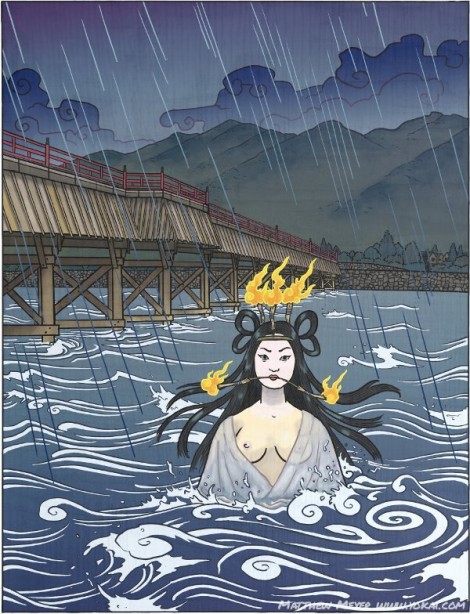Today’s yokai is one of my favorites. Not only because she just looks fierce and awesome, but because of the history and legends surrounding her. She is one of the awesome yokai whose legends go back more than 1100 years, and she is found in many old books, such as The Tale of Genji and the Tale of the Heike.
Hashihime (橋姫, はしひめ)
“Upon a narrow grass mat laying down her robe only tonight, again — she must be waiting for me, Hashihime of Uji”
– the Kokin Wakashū, 905 AD
Hashihime first appears in a collection of ancient poems known, easily enough, as the “Collection of Japanese Poems of Ancient and Modern Times,” or the Kokin Wakashū. Her name means “lady of the bridge,” but she is a lot more fearsome than that sounds.
There are a few hashihime legends from various parts of Japan: the hashihime of Uji-bashi, Kyoto, the hashihime of Nagara-bashi, Osaka, and the hashihime of Seta-no-karahashi, Shiga are the three most famous ones — however, they can be found haunting most very ancient, very long bridges in Japan.
The details of each hashihime story vary, but the main idea is always pretty similar: they tell of a beautiful young maiden, waiting by the bridge for her lover to return, but he never does. Over time, her love turns into jealously, and then into mad rage, and she transforms into a horrible demon — sometimes throwing herself into the river to drown first, sometimes transforming while still living. So great is the jealousy of the hashihime that it is said if you speak good things about another bridge while walking across the bridge that they haunt, or if you recite Noh verses that deal with a woman’s jealousy as the theme, something terrible will happen to you.
Aside from being horrible demons of “feminine rage” (don’t get angry at me — I don’t make up these terms, only translate them) and raw jealousy, hashihime are also revered as guardian deities of the bridges they haunt. There is even a shrine dedicated to the Uji Hashihime located near Uji-bashi. They are believed to guard bridges from invading armies, and they also benefit people by acting as goddesses of separation. They can be invoked in order to cut oneself off from bad things, whether it be awful luck that is dogging you, or a nasty lover that you want to break away from. Such is their power of separation that by tradition in Uji, Kyoto, newlyweds never cross the bridge where the hashihime haunts for fear of ruining their marriage. Instead, when crossing the river, they go together underneath the bridge on a boat.
Her outward appearance has a special meaning as well: she wears white robes, has her face painted white, and wears a kanawa (an iron trivet) around her head, carrying five candles. This is the required outfit for performing a very nasty curse known as ushi-no-koku-mairi,* or the “pilgrimage of the hour of the ox.” In the Heike Monogatari, she wears this outfit because she was performing this curse on her ex-husband and his second wife. Fearing for their lives, the two consult the famous onmyōji Abe-no-Seimei, who uses his power to deflect the curse back upon the jealous girl. The power of the curse corrupts her soul and transforms her into a demon, after which she flees in shame back to the river, where she remains as a hashihime.

* Ushi-no-koku-mairi is so darn cool that I am devoting a separate entry to it in my new book, The Hour of Meeting Evil Spirits. It won’t appear in this year’s A-Yokai-A-Day, though, so make sure you back the Kickstarter project to learn more about this curse, Abe-no-Seimei, and Japanese black magic!
You can read a little bit more about hashihime at yokai.com!

I LOVE the Hashihime, I think it´s my favourite yokai!
Thank you. 🙂 She is definitely one of my favorites too.